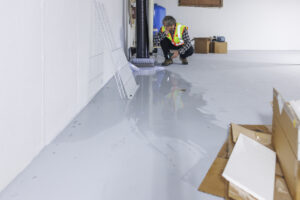Facing the Flood: How to Prepare, Respond, and Rebuild
Guest post by Troy Walsh, LMCIT loss control consultant
 It’s been raining a lot here in Minnesota over the past few weeks, and more rain is expected this week, too. When we think of rain, we think of cancelled outdoor activities and the need to reschedule events. But have you planned for water infiltration into your buildings or homes?
It’s been raining a lot here in Minnesota over the past few weeks, and more rain is expected this week, too. When we think of rain, we think of cancelled outdoor activities and the need to reschedule events. But have you planned for water infiltration into your buildings or homes?
Shifting foundations or inadequate reinforcement can create gaps and cracks that leave many buildings susceptible to water seepage into the foundation. Buildings with a foundation situated on water-saturated ground, due to the porous nature of the material, may also encounter issues with water intrusion.
Check for weak points — and plan for what to do if water gets in
When was the last time you checked your sump pump or crawl space? If you regularly check these areas – that’s great! But if you have not checked them in a while, now would be a good time to do so to prevent water intrusion. This is also a good time to ensure you are prepared in case water gets in.
- Keep the water out or away – check your gutters, outside drains, and where water typically runs to ensure they are clear and operational.
- Ensure that sump pumps are working and clear of obstructions. Do you have a backup battery or reserve power source if the power goes out?
- What do you do if water gets inside your building? Can it be easily cleaned up on a tile or concrete floor, or do you need to move furniture and carpet to dry it out?
These are all things to consider early and start planning now. The unfortunate truth is that if you put off fixing a problem, it will only get more expensive and take longer to resolve.
Resources: What to do before and after water intrusion
- Cleaning up after a flood (University of Minnesota Extension)
- Flood Cleanup to Protect Indoor Air and Your Health (U.S. Environmental Protection Agency)
- Clean-up for Home or Business after a Disaster (Minnesota Department of Health)
- Guidelines for Selecting an IAQ Consultant (Minnesota Department of Health)
Additional flood resources from LMC
- Be Prepared for Spring Flooding
- Be Prepared for Spring Flooding (Part 2)
- Tips to Follow in the Immediate Aftermath of a Flood
- After the Flood – Now What?
- Floodwater Risk – Protect Yourself!
If your city is looking for a restoration or remediation company to clean up water, reach out to your LMCIT loss control consultant. They can help get you in touch with the adjuster in your area for a list of companies.

